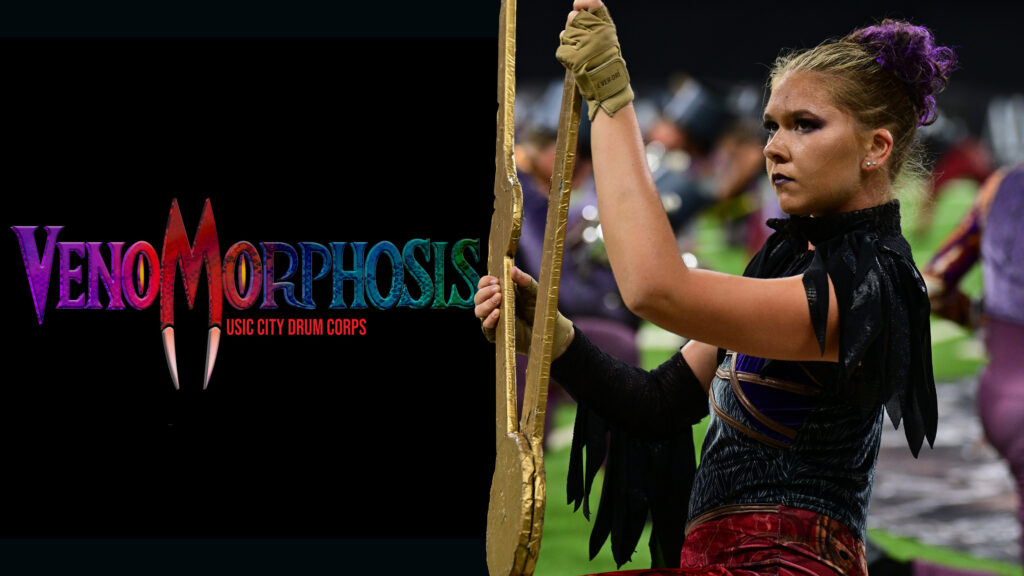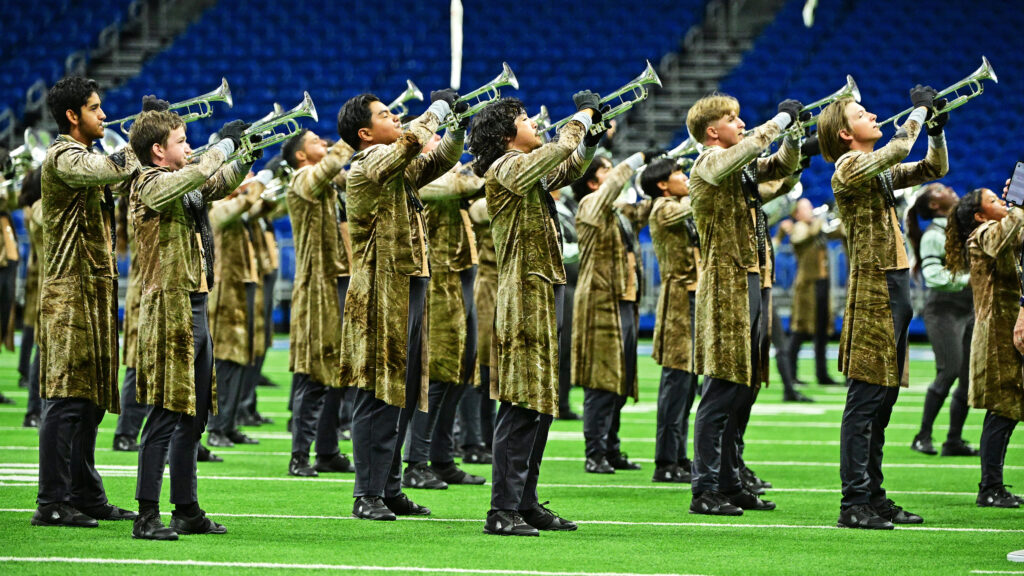The DCI World Championships first went to Massachusetts in 1994, with the events held at Foxboro Stadium. When the World Championships returned in 2005, the site of the old stadium was now a parking lot for the newer, larger Gillette Stadium. During the intervening years on the drum corps stage, color guards got their own scoring caption, amplification in the front ensemble was legalized, and any-key brass instruments became the norm.
The climate during Finals Week in 2005 was incredibly hot and spectacularly humid, breaking a 101-year-old temperature record for Foxboro. Amidst this steamy environment, the Cadets tied the Cavaliers’ three-year-old high score record, winning all top caption honors.
Phantom Regiment’s third-place “Rhapsody” production was based entirely on two of composer George Gershwin’s most famous works. Along with his brother, lyricist Ira Gershwin, George created some of Broadway’s most famous show tunes. He also collaborated with a number of others on Broadway and on pop tunes that reached the top of the charts.
Despite his fame, Gershwin sought to improve his compositional skills by asking to study with numerous famous European composers and composition teachers. Each—including Maurice Ravel, Igor Stravinsky, and Nadia Boulanger—turned him down, as they were concerned about compromising a unique and special talent. He undoubtedly would have become an even larger force in music had he not tragically died at the age of 38 from the effects of a brain tumor.
Prior to the start of the 2005 DCI Tour, Phantom Regiment’s “Rhapsody” production was already known for featuring the corps’ first male performer in the guard. Interestingly, Regiment’s fellow Midwestern all-male corps, the Madison Scouts, featured a female guest performer in the group’s “The Carmen Project” that same year.
Regiment’s show was promoted as featuring melody, melody, and more melody. Starting with several seconds of snippets of themes from “Rhapsody in Blue” performed in the front ensemble, the color guard unveiled large umbrellas, leading into the horns and drums forming a giant umbrella drill formation for the first big horn hit. The female members of the guard were attired in flapper-like costumes reminiscent of those of the Roaring 20s.
“Rhapsody in Blue” was written in 1924 and was Gershwin’s first major classical work, breaking ground by mixing classical music with jazz. The work was commissioned by bandleader Paul Whiteman, known as the “King of Jazz” for his efforts to bring jazz to a wider audience. Gershwin’s work was premiered in a New York City concert, titled “An Experiment in Modern Music.” The concert was a prestigious event; both John Philip Sousa and Sergei Rachmaninoff were in attendance.
Highlighting the visual production, the ending of Regiment’s version of the work featured a continuous squiggly line of brass players oriented on an angle. They instantly morphed to be oriented to the opposite angle and then magically reappeared on the first angle. The male guard soloist then tossed a hat in the air and caught it on the tip of his rifle.
Gershwin’s “American in Paris” was featured next. Written in 1928, it was inspired by the time Gershwin spent in Paris. It wouldn’t be until 1951 that the work reached a wider audience as an MGM musical extravaganza staring Gene Kelly, which earned the Academy Award for Best Picture.

For the work’s program notes, Gershwin wrote, “My purpose here is to portray the impression of an American visitor in Paris as he strolls about the city and listens to various street noises and absorbs the French atmosphere.” Later, he wrote, “It’s a humorous piece, nothing solemn about it … If it pleases symphony audiences as a light, jolly piece, a series of impressions musically expressed, it succeeds.”
Phantom Regiment featured the work interspersed among sections of “Rhapsody in Blue,” and at times, the two blended together so well one had to conscientiously think about which melody belonged to which of the selections.
For the reintroduction of the “Rhapsody” theme, the corps’ tubas were featured up front in the joyous melodic segment often utilized in commercials for United Airlines. This was followed by a continuous flurry of 16th-note runs in the mellophones that was so tight it was practically impossible to discern it from the mallet percussion runs the horns were duplicating.
For the bluesy ballad section of “Rhapsody in Blue,” the flag members of the color guard picked up silks that were cleverly emblazoned with a deconstructed Regiment chevron logo, the symbol’s elements set horizontally side-to-side instead of stacked vertically upon one another. This segment was treated as a romance interest between the male performer and one of the guard’s female members. A large blue umbrella served as the main prop.

A percussion feature witnessed snares, then tenors, and then bass drums taking turns presenting their talents, interspersed by two members of the front ensemble replicating tap dancing. This was surely one of the most inspired and whimsical moments witnessed in front ensemble percussion sections over the past several years. The members had tap shoes attached to their hands and in essence performed a tap routine atop a hard stone-like surface.
The last three minutes of the show returned to “American in Paris,” with the color guard section taking on accents of orange and brightly colored headdresses, soon joined with orange flags that gave the members the look of birds of paradise.
The horns and drums formed a representation of the Eiffel Tower down the 50-yard line, and then the show ended with the male guard soloist presenting his straw hat to one of the other guard members. He then ran off the field, ready for his return to America and full of fond memories of his visit to the City of Lights.

Michael Boo was a member of the Cavaliers from 1975-1977. He wrote about the drum corps activity for more than 35 years while serving as a staff writer for various Drum Corps International projects. During his lifetime Boo wrote for numerous other publications including an honors-winning book on the history of figure skating. He also was an accomplished composer. Boo passed away in 2020 and was inducted into the DCI Hall of Fame posthumously in 2021.





